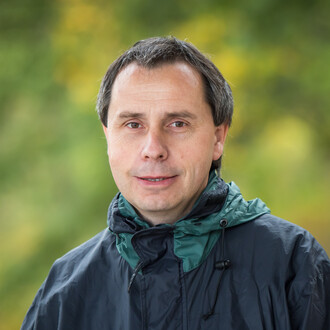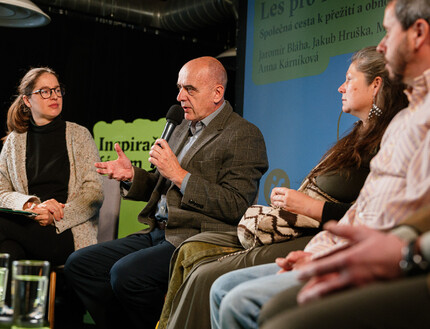As someone who has been involved with forests for three decades, how would you describe the condition of Czech forests today?
Unfortunately, it’s not a difficult question to answer, because the widespread forest dieback we’ve seen in recent decades is obvious. It began in Silesia around the turn of the millennium, when conifer monocultures at low and mid-altitudes started dying off en masse. The most severe wave hit after 2015, when large areas of forest in the Vysočina region and northern Moravia gradually vanished—though the impact was felt in nearly every region. According to data from the European ICP Forest project, Czech forests have consistently ranked among the worst in Europe in terms of health.
Due to poor management and climate change, spruce forests—which have been planted in unsuitable environments—are dying, and the consequences are severe.
Was this what prompted you to get involved in ecology personally?
Back in the early 1990s, we at Hnutí Duha (the Rainbow Movement) started a petition against deforestation of rainforests. However, we soon realized that as Czech citizens, we had very little power to influence what was happening abroad. We also took the criticism from our colleagues in the Global South seriously, who questioned, “So, you destroyed your own rainforests, and now you want to lecture us on ours?” So in 1994, Hnutí Duha launched a program to protect Czech forests. This year marks its 30th anniversary.
What makes Czech forests and our approach to them unique? I always think of the argument against wind farms here—how the wind supposedly behaves differently in the Czech Republic than elsewhere.
We hear similar things from foresters, who insist that our conditions are somehow unique. But they’re really not. What is specific here is a mindset: people are more likely to look for reasons something can’t work, rather than looking for ways that it could.
The Austro-Hungarian model of forest management—clear-cutting (logging that leaves bare land) and conifer monocultures—took hold here and stuck. Germany, by contrast, realised 25 years ago that climate change was real and began transitioning to more resilient mixed forests. But here, the Ministry of Agriculture downplayed it. It wasn’t until 2018 that new regulations increased the proportion of deciduous and fir trees. In addition, state forests neglected to take consistent action against bark beetle outbreaks.
Increasing resilience
So how prepared are our forests for climate change? And what role do they play in overall adaptation strategies?
Very few forests here are truly prepared. In areas where forests are facing widespread decline, maps are covered in red and yellow. This kind of dieback is likely to repeat itself.
 Forests are carbon sinks. Until 2018, they helped mitigate the climate crisis. But since then, Czech forests have actually emitted carbon—likely the only ones in Europe to do so—due to excessive logging. The scale of this logging is so great that it releases as much carbon as car traffic. Who would have imagined that forests, long seen as climate allies, would now instead be contributing to the problem? Worse still, state and private forest owners have negotiated exemptions allowing them to log in protected areas at levels that are otherwise illegal.
Forests are carbon sinks. Until 2018, they helped mitigate the climate crisis. But since then, Czech forests have actually emitted carbon—likely the only ones in Europe to do so—due to excessive logging. The scale of this logging is so great that it releases as much carbon as car traffic. Who would have imagined that forests, long seen as climate allies, would now instead be contributing to the problem? Worse still, state and private forest owners have negotiated exemptions allowing them to log in protected areas at levels that are otherwise illegal.
And we can expect even more widespread collapse of coniferous forests.
It’s coming. But we shouldn’t fall into despair—we need to start making our new forests more resilient. Natural regeneration should be used wherever possible. Forests grown from seed are far more resilient than those planted with nursery-raised saplings. However, the Ministry of Agriculture supports the nursery business.
Forests should also be diverse in species, age, and structure. Instead of rushing to replant clearings, we should restore them gradually, using pioneer species like rowan, aspen, and alder. These short-lived trees can prepare the dry soil so that firs, beeches, and shade-tolerant species can later thrive in their shade. In short: avoid one-size-fits-all, rushed reforestation.
What other challenges does forest restoration face?
The biggest barrier is the overpopulation of game—deer, roe deer, and especially non-native species like fallow and sika deer. They destroy or severely damage most young deciduous and fir trees. As a result, billions spent on forest restoration end up in their stomachs—not to mention the damage done to natural regeneration.
This is exactly what the amendment to the Hunting Act aims to address. It strengthens the rights of forest owners and introduces hunting quotas based on forest damage levels. If lawmakers fail to pass it—or water it down—we won’t be able to restore diverse forests at all.
What laws do we need?
A new forest law is set to be approved in the fall. What do you expect from it—or perhaps, what do you not expect?
The current two-year time limit for afforestation should be relaxed to give foresters the flexibility to wait for natural regeneration. The proposed amendment extends this period to five years, but even that’s too short—and frankly, pointless. In some places, forests may regenerate in two years, in others it could take fifteen. But time is actually on our side when it comes to natural regeneration and ensuring future forest resilience.
What else should change?
We should allow certain forests to develop freely—completely unmanaged by humans. Right now, you’ll only find these in some national parks and nature reserves, and even there, logging still takes place in many areas. It sounds unbelievable, but it’s true. With the climate crisis looming, we need more areas like this. In order to adapt, we need real-life examples of how forests behave without human interference. Otherwise, we won’t know how to prepare for worst-case scenarios—like predictions that forests could be replaced by dry Mediterranean-style scrubland. We must give forests a chance to respond naturally to climate change. Only then can we draw conclusions for commercial forest management.
We must give forests a chance to respond naturally to climate change. Only then can we draw conclusions for commercial forest management.
Old-growth forests also serve as vital carbon sinks. When we log them, only a small fraction of the wood is used in long-lasting products like construction timber or furniture. Most of it is consumed quickly—turned into paper or burned—releasing carbon back into the atmosphere. And when we clear-cut, we even release the carbon stored in the soil.
What should an ideal forest law contain?
Ideally, it should be a comprehensive package—a forest law, a hunting law, a landscape protection law, and revised management rules for Lesy ČR, the state forestry company.
The forest law should establish clear ecological limits on forest management and apply them equally to all. Some outdated practices, like planting trees in perfectly aligned rows on slopes, should be relaxed for landowners. At the same time, it should introduce landscape-level sustainability standards—for example, limiting clear-cutting, which degrades the land where future forests must grow.
It should also regulate species composition to avoid repeating the mistake of planting monoculture spruce forests. Unfortunately, the current draft does the opposite—it removes these requirements altogether. While landowners should have some freedom, riskier tree species like spruce at lower elevations need to be limited. We also need stricter controls on the damage caused by heavy machinery during logging. The proposed law talks a lot about ‘liberalisation’ but completely overlooks these essential safeguards.
To be able to imagine a forest without humans
What is the main political dispute about forests today?
If we are to leave some forests completely unmanaged, Lesy ČR and some foresters and politicians are fiercely opposed to it, even though we propose to only leave a few percent of the forests to nature.
Why?
In my opinion, it's a matter of conservative views. People have a hard time giving up control. We want freedom for ourselves, but we don't want to give that same freedom to other fellow inhabitants of the planet. I see a certain overall ideology in this. A large number of foresters simply cannot imagine that the forest can function without them, do a better job of managing itself, or potentially provide valuable lessons to humans. This is something that only a few foresters are able to imagine.
A large number of foresters simply cannot imagine that the forest can function without them, or even do a better job of managing itself.
But there are some who think this way.
Certainly, there are many of them. There is even an association for nature-friendly forestry called PRO SILVA BOHEMICA. There are politicians like this, too. Not all politicians are careerists or profiteers—many want to help nature as well. However, at the political level, it’s usually the foresters who want to plant, set clear standards, and avoid giving more space to nature who assert themselves.
The problem is, I’ve been working at Hnutí Duha for 30 years, during which time the politicians keep changing. So, we start working with those who are inclined to help, but they leave after a term and others take their place, so there’s no continuity. Overall, however, there are always only a few of them.
Up close, everything is alive
What potential do Czech forests have in terms of biodiversity, especially when it comes to rare animals such as bears, lynxes, or wolves? What is their future in our country?
If we look at the "flagship species," the potential is good. We've got wolves, the occasional bear, and even otters are returning. Beavers are amazing. They can revitalise the landscape much faster than engineers can. Beavers know exactly where to build a dam to hold back water in the landscape—and they do it for free.
But when it comes to overall biodiversity, things aren’t so promising. Despite all the strategies adopted, we haven’t been able to stop the decline in diversity, either at the larger European level or at the national level in the Czech Republic. The EU has adopted a new biodiversity protection strategy through 2030. The previous strategy, set for 2020, wasn’t fulfilled, and the new one is more ambitious. Among other things, it calls for 30% of Europe’s area to be made up of protected zones, and 10% to be strictly protected areas where natural processes are left undisturbed or are supported by specific management measures to encourage biodiversity. The Czech Republic is far from meeting this objective, and the steps proposed by the Agency for Nature and Landscape Conservation (Agentura ochrany přírody a krajiny) are not sufficient.
Beavers are amazing. They can revitalise the landscape much faster than engineers. Beavers know exactly where to build a dam to hold back water in the landscape—and they do it for free.
Therefore, a political agreement is needed to place some of the state forests—those currently outside the protected areas—under strict protection. If we want to preserve biodiversity, the current system of protected landscape areas simply isn’t enough. We also need to protect biodiversity in economic forests and leave more standing timber wherever we can. We need to stop clear-cutting because the most important part of biodiversity is in the soil. In one handful of healthy forest soil, you can find as many organisms as there are people on the planet. When you clear-cut a forest, the soil loses shade, the sun beats down, it dries out, and much of the biodiversity disappears.
Many people are unaware of the richness that surrounds them in forests. Can you point out a feature of forests that people often forget or don’t even know about?
People who practice forest therapy, for example, certainly have a lot of experience with this. Personally, I find it most impressive when I am in a forest where the natural life cycle of all organisms is allowed to take place—even if that process is accelerated by a landslide, storm, drought, or bark beetle. I remember the first time we saw those areas of dead trees from a distance in the Bavarian Forest National Park. It was a very strange feeling, and you wonder whether it’s even a good thing. But the moment you get closer, you see how everything is alive there.
In places where the entire cycle of life—including death—is preserved, a person can accept that they are part of it all.
I like to walk for a while in a forest where there are dead trees with fallen, broken, rotting ones among them—and new trees growing through it all. When you spend time in that kind of forest, it begins to affect you in ways beyond your thoughts. Maybe it’s just my assumption, but in places where the full cycle of life—including death—is preserved, a person can reach a state where they accept that they are part of it all. And that is a profound experience that makes you feel good.
What can we collectively do for forests?
We at Hnutí Duha have a call to Save the Forests, which addresses the Forest Act, the Hunting Act, and the Nature Conservation Act in terms of wildlife protection. People can join this appeal. The more people who sign it, the more support we have for our proposals when negotiating with politicians. As of today, we have about 88,000 signatures. Once we reach 100,000, the appeal’s influence will be even greater. So when those laws are being discussed, it helps immensely if people write to members of parliament themselves.
People can also help directly in the forest. We offer Weeks for the Landscape, where volunteers spend a week helping out in the forest. There’s also guerrilla forestry, for example, where people can plant pioneer birch or cranberry seeds directly on clearings. We also provide instructions on how to work with the seeds. We have Mixture for the Forest cards available for download on our website, which families can take into the forest to discover all the different ways they can help. Lastly, people can, of course, support us with a financial donation – without which we wouldn’t be able to do what we do.
Rád se chvíli pohybuji v lese, kde jsou i odumřelé stromy, popadané, polámané, tlející, a mezi nimi zároveň stromy nové. Když tím člověk chvíli chodí, začne na něj takový les působit i jinak než skrze myšlenky. Možná je to jen moje domněnka, ale tím, že je na takových místech zachovaný celý koloběh života včetně smrti, může se tam člověk dostat do stavu, ve kterém sám přijme, že je součástí toho všeho, A to je zásadní prožitek, při kterém se člověk cítí dobře.
Jaromír will speak at the Inspiration Forum in the program Forest for Us and Us for the Forest: A Common Journey to Survival and Restoration (Sunday, October 27th, 12:30 - 2:00 PM).
The interview originally appeared on Aktuálně.cz.





